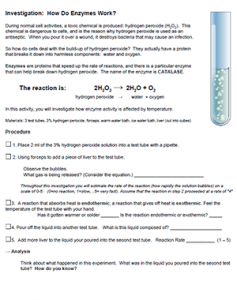
Explore enzymes with this engaging lab on hydrogen peroxide and catalase. NGSS requires students to have a basic understanding of organic compounds, and the functioning of proteins. These concepts can be difficult for students to conceptualize. The instructions are straightforward, with boxes for students to check as the complete steps. For low achieving students, you can even walk them through the steps as a class. Overall, students will get a hands-on experience on how proteins in the body can catalyze reactions.
In this lab, students place cubes of liver in a test tube with 2 ml of hydrogen peroxide. The peroxide will bubble, indicating that a reaction has taken place. My students are fascinated by this reaction! Plus, you can go into some background about how hydrogen peroxide is actually not a great disinfectant for wounds.
By the end of the lab, students discover that the enzymes in the liver break down the hydrogen peroxide into water and oxygen. The enzyme, catalase, is reusable, as observed when you add more peroxide to the liver and create additional bubbling. When they pour off the bubbled water and add liver enzyme to it, no bubbles occur. Why? That liquid is just water (and oxygen).
Next, they compare the amount of bubbles created when the liver is warm or cold, by placing the test tubes in a water bath. Some students may predict that the boiled liver will have a lot of bubbles, but it does not. In fact, the reaction doesn’t work at all, which allows for a discussion about denaturation of proteins. (With freshman, I would prefer not to have boiling water baths due to safety concerns.) You can also set up a demonstration to show what happens when the liver is boiled. Students may be surprised to learn that boiled liver doesn’t react at all. Denaturation!
This version is shortened and gives much more specific instruction than the AP Lab: Enzymes which also includes an inquiry section.
An extension of the AP lab (Concentration of Enzymes and Reaction Rates) looks specifically at how concentrations affect the rate of reaction. The filter paper will sink and then float as oxygen from the reaction is created, providing an indirect measure of reaction rate.
HS-LS1-1 Construct an explanation based on evidence for how the structure of DNA determines the structure of proteins which carry out the essential functions of life through systems of specialized cells
HS-LS1-2 Develop and use a model to illustrate the hierarchical organization of interacting systems that provide specific functions within multicellular organisms
Related Resources
Enzyme and Substrate Concentrations – Graphical Analysis
Catalase and Enzymes – test different food items for the presence of catalase, with CER chart
Concentration and Reaction Rates of Enzymes – using floating disks to determine reactions rates
Investigation: Apples and the Pectinase Enzyme – quantitative lab where students measure apple juice

